|
The DV2000/DV4 can link to an Avaya IP Office PBX using a TCP connection where the VMS is the client. This link uses the protocol and features listed in the table below:
Link Type
|
Protocol Used
|
Log File Prefix
|
Features Supported
|
TCP client
|
IP Office Config. Service, TAPI (for DND)
|
IPOFFICE
|
Name change, DND, Set user rights group (phone COS)
|
Configure the Link
To configure the physical link to the IP Office, follow these steps:
1. Using Activity Monitor, stop the voice mail service.

2. Run the System Configuration application and select Features | Connectors.

3. Select the IP Office property page.
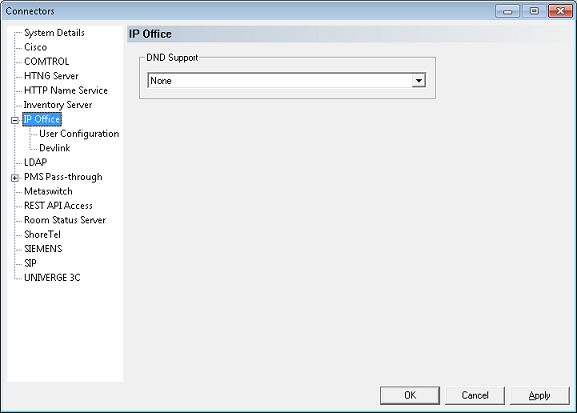
| 4. | Select how you want DND status handled. If you do not want to pass DND status to the PBX, select None. |
| 5. | Select the User Configuration property page. |
| 6. | Select the location for this PBX. In most cases the default selection, Default Location, is the correct choice. Then check the Enabled box to enable the connector for the selected location. |
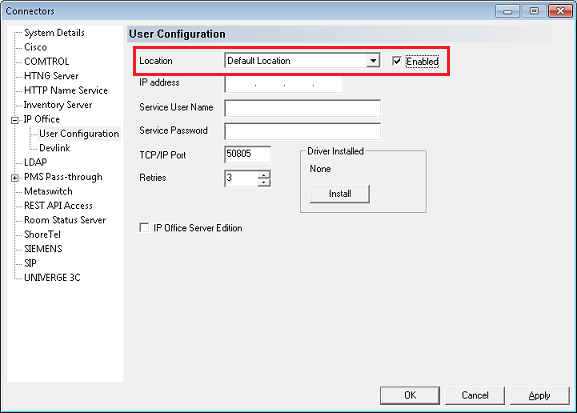
| 7. | Enter the IP address assigned to the PBX. The VMS connects to the PBX as a client, so the IP address of the PBX is required. |
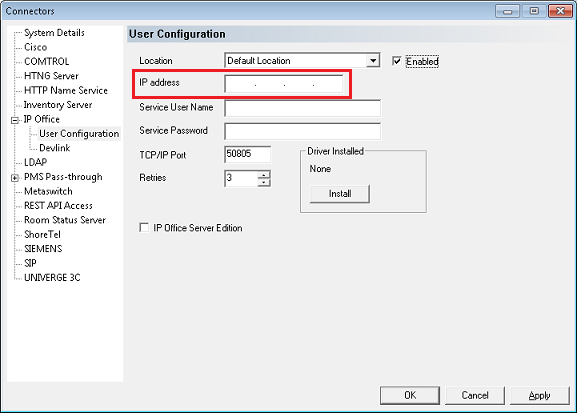
| 8. | Enter the user name and password required to login to the PBX, using the boxes provided. |
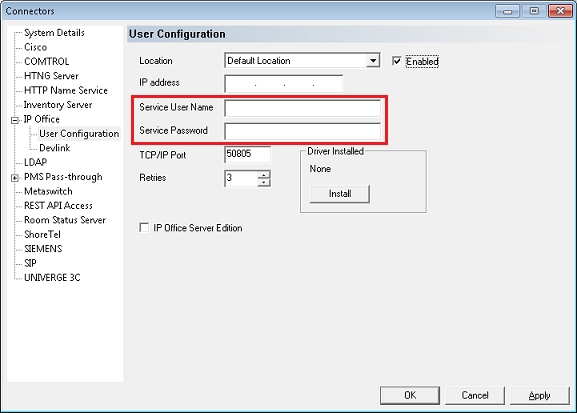
9. Do not change the TCP/IP Port setting unless required to do so by Avaya. This is the port number required to connect to the PBX.
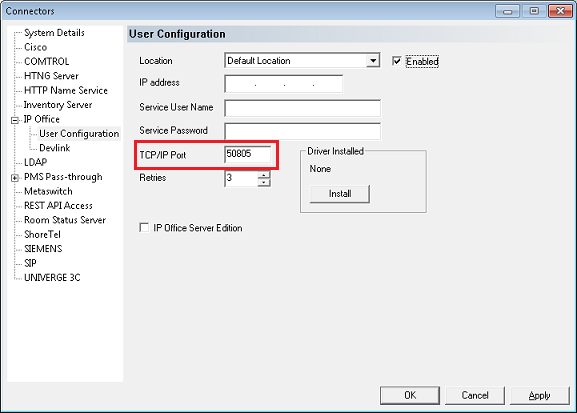
| 10. | Set the number of times to retry sending a change request if the first attempt fails. The default value is 3 retries (for a total of 4 attempts). |

11. Check the IP Office Server Edition box only if you are using that version of the PBX; otherwise, leave the box unchecked.
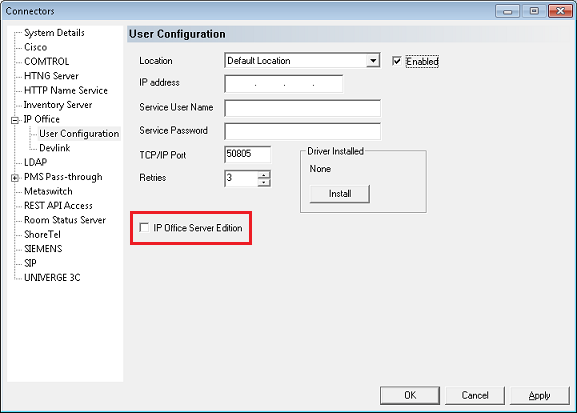
| 12. | The Driver Installed section displays the version number of the installed driver. If it says None, then no driver is installed. Click the Install button to launch the IP Office Driver Install Setup Wizard which will guide you through the steps to install the driver. |
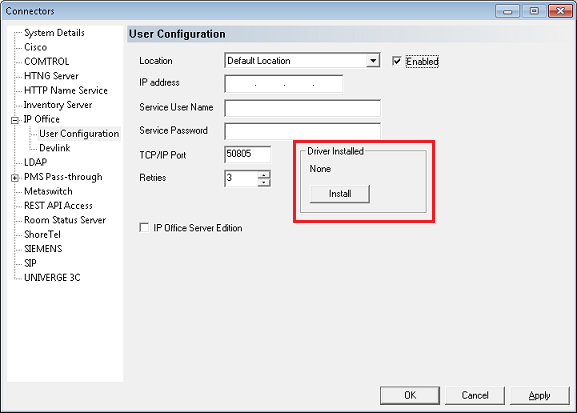
13. Click Apply to save your changes without closing the dialog.
14. Repeat steps 6 through 13 for each location on the VMS that uses the same IP Office PBX.
15. Click OK to save your changes and close the Connectors dialog.
16. Continue to the next section to configure the hospitality settings.
Configure the Hospitality Phone Control Settings
After you have configured the connector settings for the IP Office link, you need to configure the hospitality service to use that connector and you also need to configure the phone control settings.
To do so, follow these steps:
| 1. | Select Features | Hospitality. |
| 2. | If prompted, select the PMS instance (as shown below). This dialog is only displayed if you are licensed for more than one PMS instance. Otherwise, skip to step 3. |

3. Select the Phone Control property page.
4. In the PBX section, use the Type drop-down list box to select Avaya IP Office.
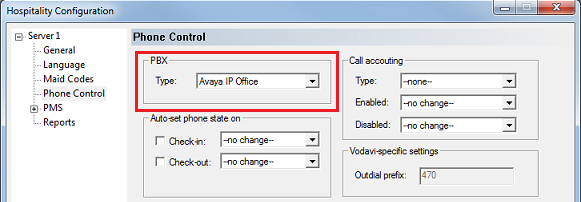
| 5. | If you are not using Hansen CASH or Metropolis call accounting, skip to step 6. If you are, use the Type drop-down list box in the Call accounting section to select the call accounting software. Then use the Enabled and Disabled boxes to select the appropriate COS (or call restriction level) to send to the PBX when the call accounting software signals that the room phone should be enabled or disabled. |
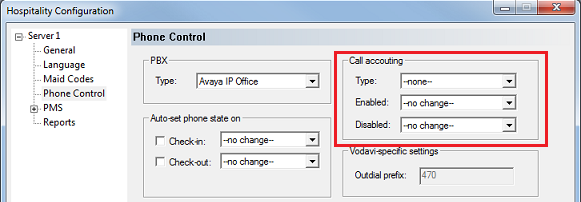
| 6. | In the Auto-set phone stat on section: If your PMS sends messages to the VMS to change the phone COS, or if you enabled the call accounting settings in step 5, make sure both check boxes are unchecked. However, if you aren't using call accounting and your PMS protocol does not offer a message command for setting the phone COS, you may wish to enable both options and use the associated drop-down list boxes to select which phone COS (or restriction level) to send to the PBX when the room is checked in and when it is checked out. The --no change-- option acts the same as unchecking the check boxes. |
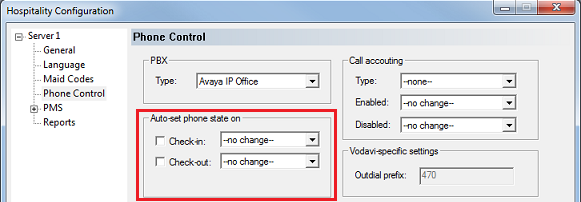
| 7. | In the User group restrictions section: When you selected Avaya IP Office in step 4, above, the system automatically reset the entries in this table to default values. You may need to change the PBX values to match the appropriate user rights groups that you defined on your PBX. You will also need to enter the correct matching values for your PMS in the PMS Value column. To enter a PMS value, click in the box under the PMS Value heading for the row that has the matching PBX value. Then enter the value exactly as the PMS will send it (typically, this will be a single digit number). Repeat for each PMS value. Each PMS value must be entered in the table only once; it is not necessary to enter a PMS value for every PBX value. You can change the Display Text as well if you wish; this is what will be displayed in InnDesk. |
Note: The PBX Value entries are case-sensitive.
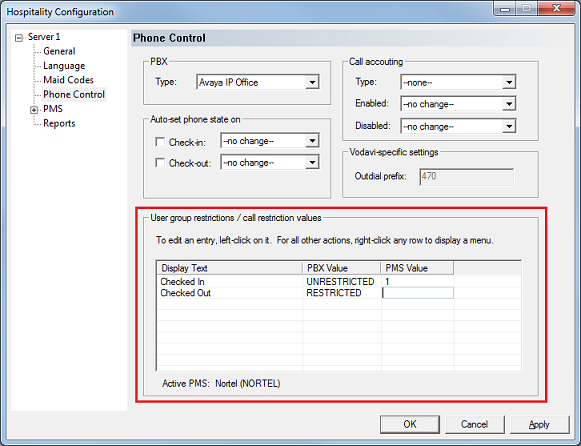
8. Click OK to save your changes and close the dialog.
9. Once you are finished with all configuration changes, close System Configuration.
10. Using Activity Monitor, restart the voice mail service.

|





